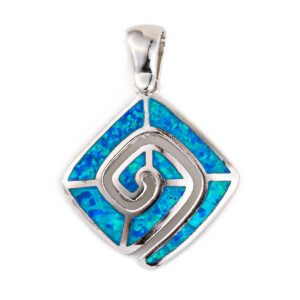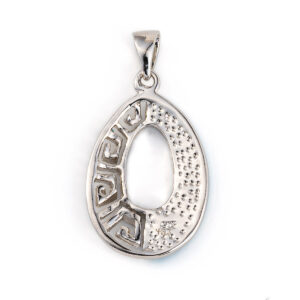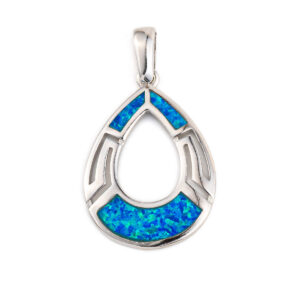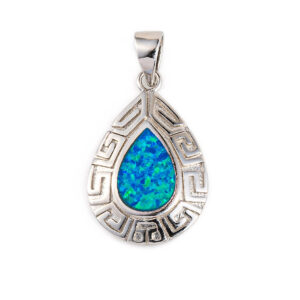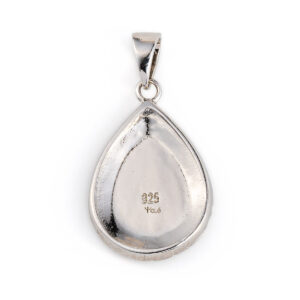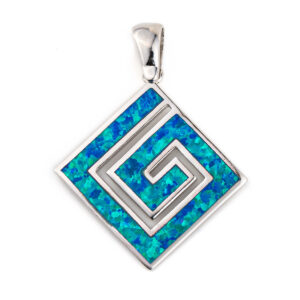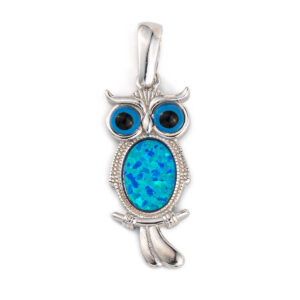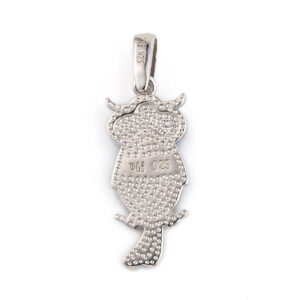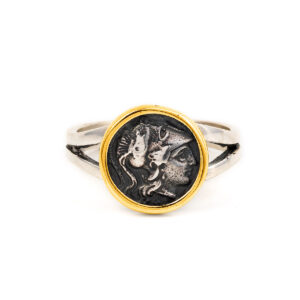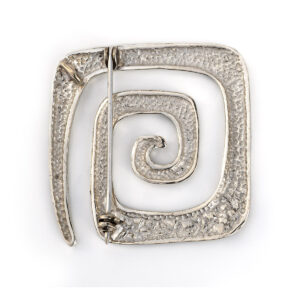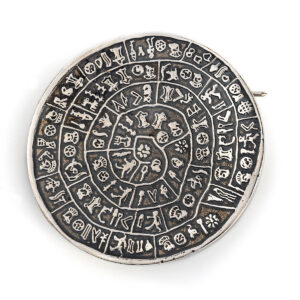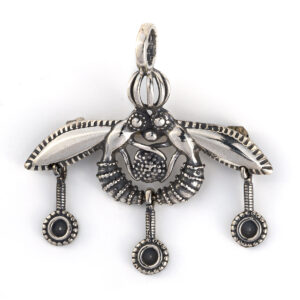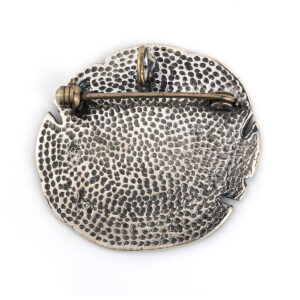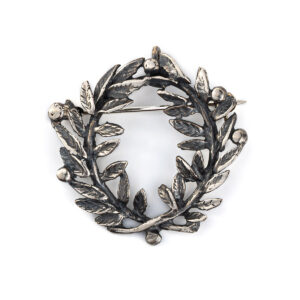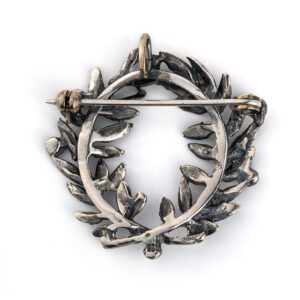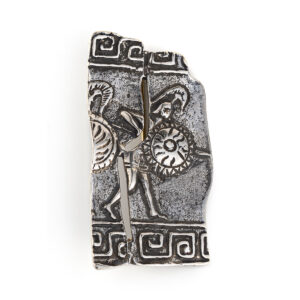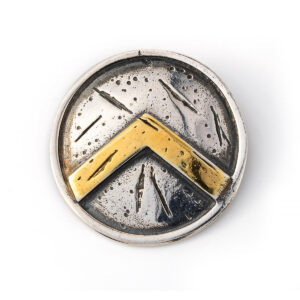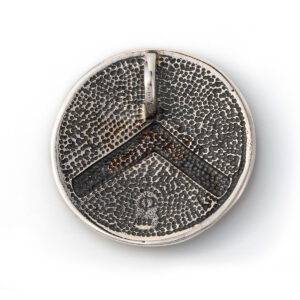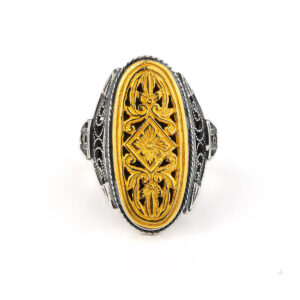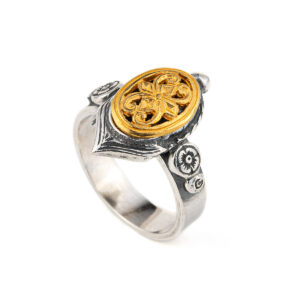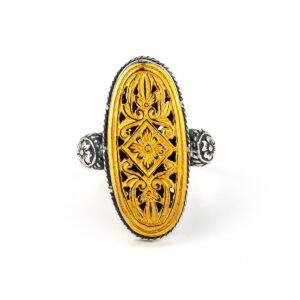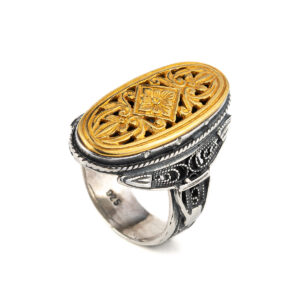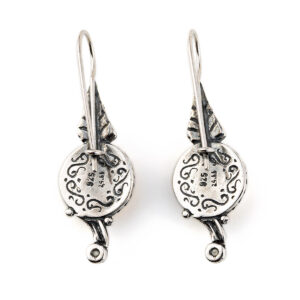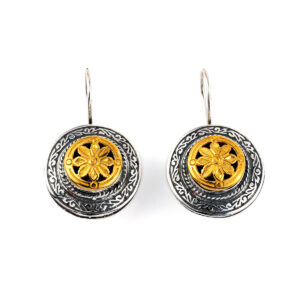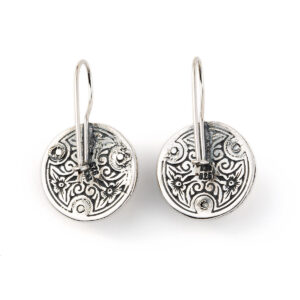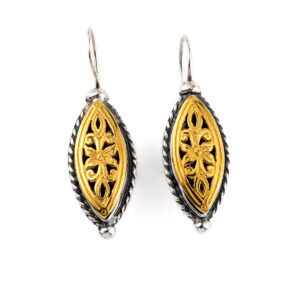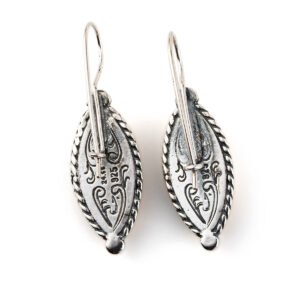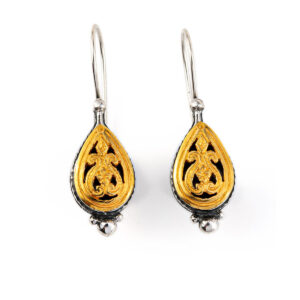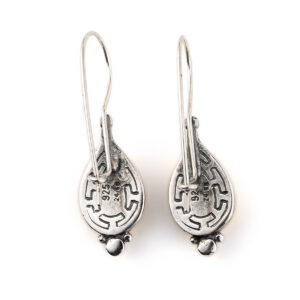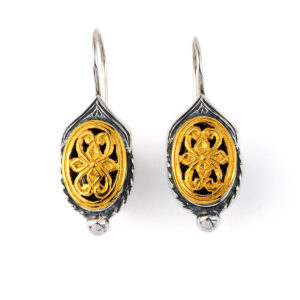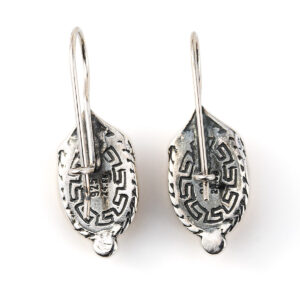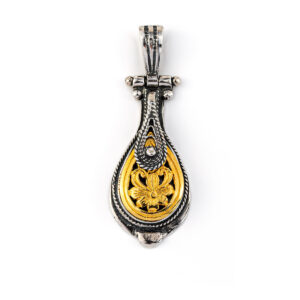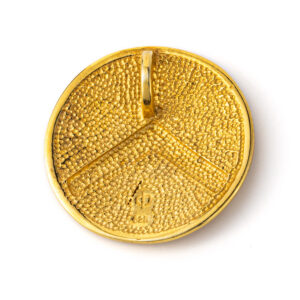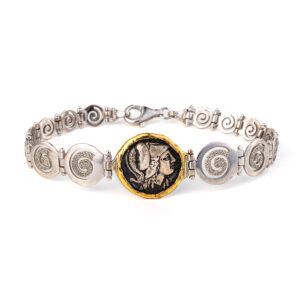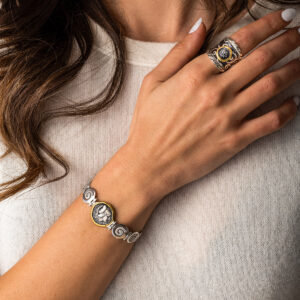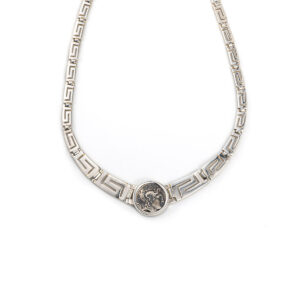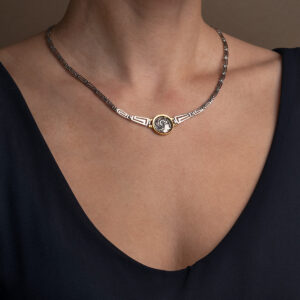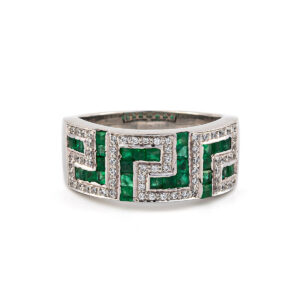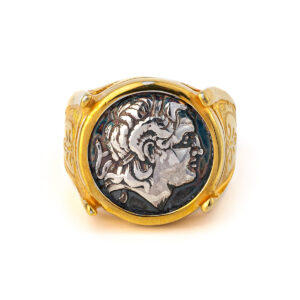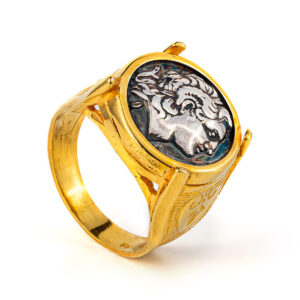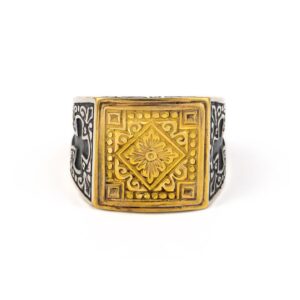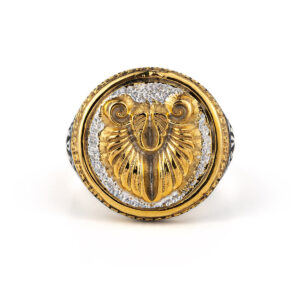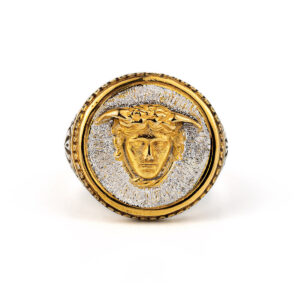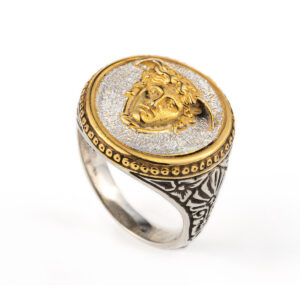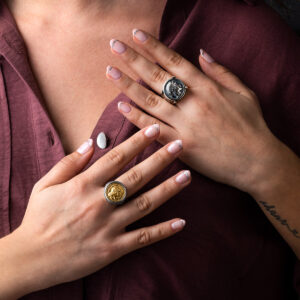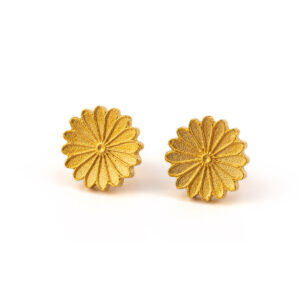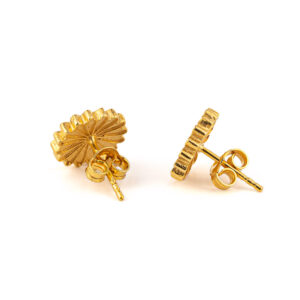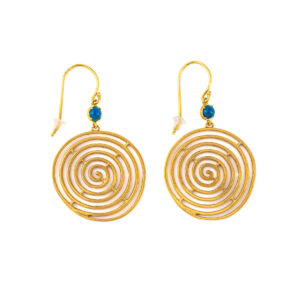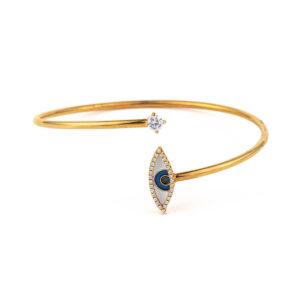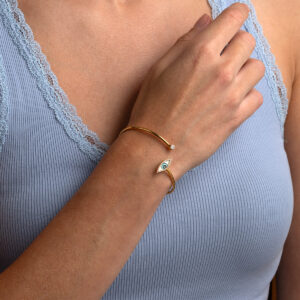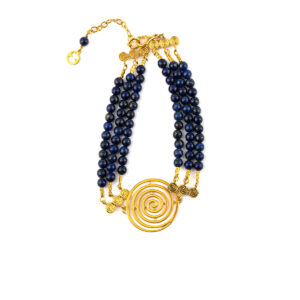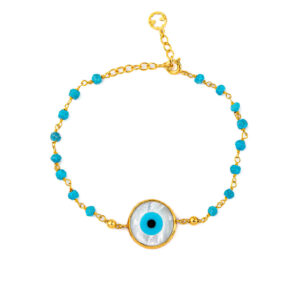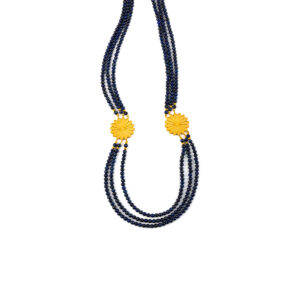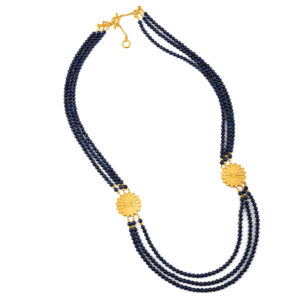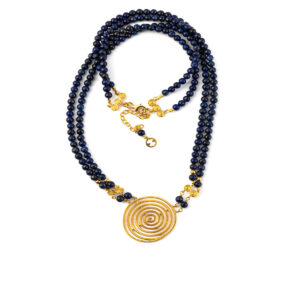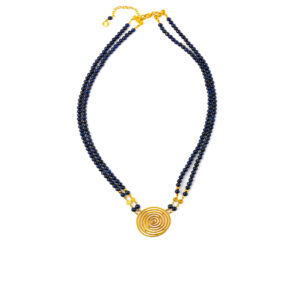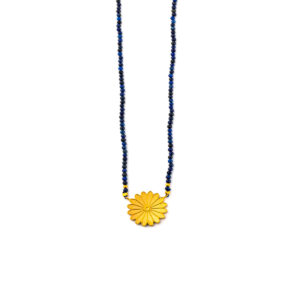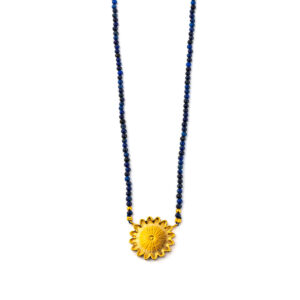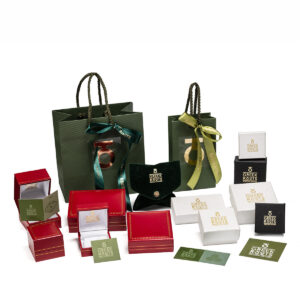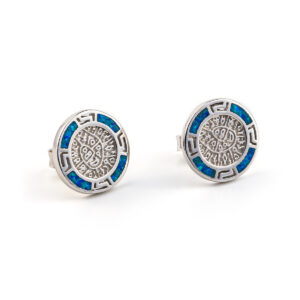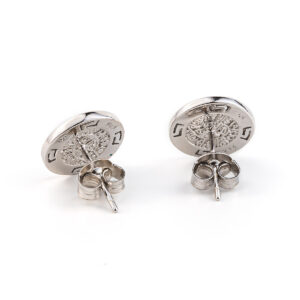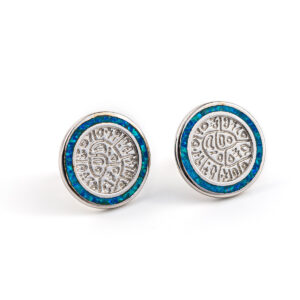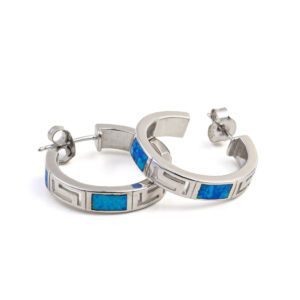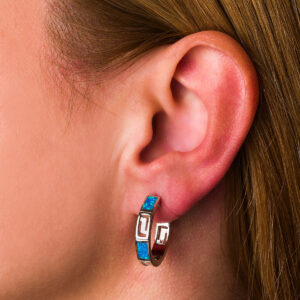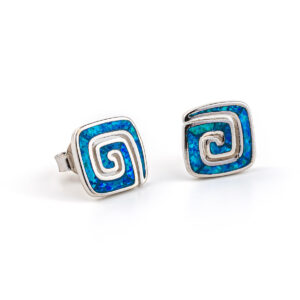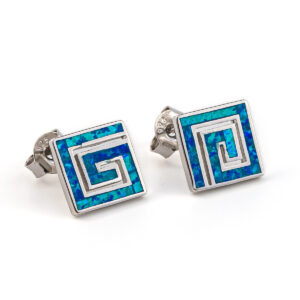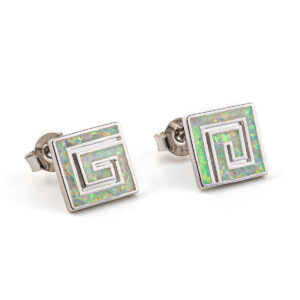meander greek key pendant blue opal sterling silver
A sterling silver pendant featuring the meander symbol with a blue opal stone.
Made of 925⁰ sterling silver.
Handmade in Greece.
Meander design is a decorative border constructed from a continuous line, shaped into a repeated motif. Such a design is also called the Greek fret or Greek key design, although these are modern designations. On the one hand, the name “meander” recalls the twisting and turning path of the Meander River in Asia Minor, and on the other hand, as Karl Kerenyi pointed out, “the meander is the figure of a labyrinth in linear form” the meaning is that there is no beginning and no end in some cases so it becomes the symbol of long life and eternity.
Meander Pendant – 925 Sterling Silver with Opal
Pendant with Meander design and a blue opal stone.
Made of 925⁰ sterling silver.
Handmade in Greece.
Meander design is a decorative border constructed from a continuous line, shaped into a repeated motif. Such a design is also called the Greek fret or Greek key design, although these are modern designations. On the one hand, the name “meander” recalls the twisting and turning path of the Meander River in Asia Minor, and on the other hand, as Karl Kerenyi pointed out, “the meander is the figure of a labyrinth in linear form” the meaning is that there is no beginning and no end in some cases so it becomes the symbol of long life and eternity.
meander pendant – blue opal sterling silver
Pendant with Meander design and a blue opal stone.
Made of 925⁰ sterling silver.
Handmade in Greece.
Meander design is a decorative border constructed from a continuous line, shaped into a repeated motif. Such a design is also called the Greek fret or Greek key design, although these are modern designations. On the one hand, the name “meander” recalls the twisting and turning path of the Meander River in Asia Minor, and on the other hand, as Karl Kerenyi pointed out, “the meander is the figure of a labyrinth in linear form” the meaning is that there is no beginning and no end in some cases so it becomes the symbol of long life and eternity.
greek key blue opal silver pendant
Pendant with Meander design and a blue opal stone.
Made of 925⁰ sterling silver.
Handmade in Greece.
Meander design is a decorative border constructed from a continuous line, shaped into a repeated motif. Such a design is also called the Greek fret or Greek key design, although these are modern designations. On the one hand, the name “meander” recalls the twisting and turning path of the Meander River in Asia Minor, and on the other hand, as Karl Kerenyi pointed out, “the meander is the figure of a labyrinth in linear form” the meaning is that there is no beginning and no end in some cases so it becomes the symbol of long life and eternity.
Greek Key Pendant – Sterling Silver with Blue Opal
A sterling silver pendant featuring the meander symbol with a blue opal stone.
Made of 925⁰ sterling silver.
Handmade in Greece.
Meander design is a decorative border constructed from a continuous line, shaped into a repeated motif. Such a design is also called the Greek fret or Greek key design, although these are modern designations. On the one hand, the name “meander” recalls the twisting and turning path of the Meander River in Asia Minor, and on the other hand, as Karl Kerenyi pointed out, “the meander is the figure of a labyrinth in linear form” the meaning is that there is no beginning and no end in some cases so it becomes the symbol of long life and eternity.
Wisdom Owl – Blue opal pendant pendant
This is a silver pendant representing the owl – the symbol of Athena. The pendant is decorated with blue opal.
Made in 925⁰ sterling silver
Handmade item.
Athena Coin Ring – Sterling Silver & Gold Plated
Athena Coin Ring – Sterling Silver & Gold Plated
This Ancient Greek coin represents Athena Chalinitis on the front side and the inscription “ΑΛΕΞΑΝΔΡΟΥ” on the back side.
Made of 925⁰ sterling silver and gold plated.
Handmade item.
Athena – Stater of Corinth
This silver stater of Corinth depicts the head of Athena Chalinitis.
Meander Brooch – Sterling Silver
Made in 925⁰ sterling silver.
Handmade item.
Explore Meandros Collection
Meandros design is a decorative border constructed from a continuous line, shaped into a repeated motif. Such a design is also called the Greek fret or Greek key design, although these are modern designations. On the one hand, the name “meander” recalls the twisting and turning path of the Meander River in Asia Minor, and on the other hand, as Karl Kerenyi pointed out, “the meander is the figure of a labyrinth in linear form” the meaning is that there is no beginning and no end in some cases so it becomes the symbol of long life and eternity.
Minoan Phaistos Disc brooch
Minoan Phaistos Disc brooch.
Made in 925⁰ sterling silver.
Handmade item.
The Phaistos Disc is a disk of fired clay from the Minoan palace of Phaistos on the island of Crete. Now, the island of Crete is part of modern Greece. The disc was discovered in 1908 by the Italian archaeologist Luigi Pernier in the Minoan palace-site of Phaistos. While it is not clear that it is a script, most attempted decipherments assume that it is; most additionally assume a syllabary, others an alphabet or logography or a calendar.
Malia bees pendant and brooch in sterling silver
34,00€ – 79,00€Made in 925⁰ sterling silver.
Handmade item.
The Malia honeybee pendant was discovered at Chryssolakkos, of the Minoan Palace of Malia on the island of Crete, and is thought to date to c.1800 BC. The named Chryssolakkos that means the “pit of gold” because of the precious objects that the farmers used to find there. The Minoan Palace is situated 3 km east of Malia town and is the third most significant known Minoan Palace after Knossos and Phaistos.
This pendant is in the shape of two bees.
Sterling Silver Brooch Ionic Column
Made in 925⁰ sterling silver. Oxidized finish.
Handmade item.
There are three distinct orders in Ancient Greek architecture: Doric, Ionic, and Corinthian. The Ionic capital is characterized by the use of volutes. The Ionic columns normally stand on a base which separates the shaft of the column from the stylobate or platform; the cap is usually enriched with egg-and-dart. It was a popular style in Athens.
Owl Of Wisdom Brooch – 925 Sterling Silver
A beautiful brooch with the wisdom owl.
Made in 925⁰ sterling silver. Oxidized finish.
Handmade item.
Olive Leaf Wreath Brooch – Sterling Silver
This is a beautiful brooch with the olive wreath.
Made in 925⁰ sterling silver.
Handmade item
The olive wreath also known as kotinos was the prize for the winner at the ancient Olympic Games. It was an olive branch, of the wild- olive tree that grew at Olympia,intertwined to form a circle or a horse-shoe. According to Pausanias it was introduced by Heracles as a prize for the running race winner to honour his father Zeus. In the ancient Olympic Games there were no gold, silver, or bronze medals. There was only one winner per event, crowned with an olive wreath made of wild-olive leaves from a sacred tree near the temple of Zeus at Olympia. Olive wreaths were given out during the 2004 Summer Olympics in Athens in honor of the ancient tradition, because the games were being held in Greece.
Spartan Mural Reproduction Silver Pendant Brooch
This handmade sterling silver brooch depicting ‘Leonidas’.
Made in 925⁰ sterling silver. Oxidized finish.
Handmade item.
Leonidas was a warrior king of the Greek city-state of Sparta. Arguably, one of the greatest heroes in the history of ancient Greece. In 480 B.C Leonidas led an army of 6,000 to 7,000 Greeks from many city-states, including 300 Spartans, fought the invading Persian army at the pass of Thermopylae. Leonidas of Sparta blocked the only road through which the massive army of Xerxes could pass. The Persians succeeded in defeating the Greeks but sustained heavy losses. A local resident named Ephialtes led the Persian general by a mountain track to the rear of the Greeks. King Leonidas sent away all the Greek troops and stayed behind with 300 Spartans, 400 Thebans, and 700 Thespian volunteers who refused to leave. They were all killed in the battlefield, protecting their homeland.
Spartan Shield Pendant – Sterling Silver & Gold Plated
This pendant represents the shield of the Spartans.
Made in 925⁰ sterling silver and gold plated.
Handmade pendant.
The letter lambda (Λ), standing for Laconia (the administrative capital of Sparta) or Lacedaemon (ancient name for the city of Sparta), which was painted on the Spartans’ shields, was first adopted in the 420s BC, and quickly became widely known Spartan symbol. Military families passed on their shields to each generation as family heirlooms.
Vintage Flower Ring – silver and gold plated
This ring is inspired by Byzantine Historical period respecting Greek traditional art. A very elegant ring decorated with engravings.
Handmade item.
Made in 925⁰ sterling silver and gold plated.
Handmade item.
Engraved ring – 925⁰ sterling silver and gold plated
This ring is inspired by Byzantine Historical period respecting Greek traditional art.
Made in 925⁰ sterling silver and gold plated.
Handmade item.
Vintage Engraved Flower Ring – silver and gold plated
This ring is inspired by Byzantine Historical period respecting Greek traditional art. A very elegant ring decorated with engravings.
Handmade item.
Made in 925⁰ sterling silver and gold plated.
Handmade item.
Vintage Engraved Flower Drop Earrings – silver and gold plated
Vintage dangle earrings with engravings.
Made in 925 sterling silver and gold plated.
Vintage Engraved Flower Earrings – silver and gold plated
Vintage dangle earrings with engravings.
Made in 925 sterling silver and gold plated.
Vintage Engraved dangle earrings – silver and gold plated
Vintage dangle earrings with engravings.
Made in 925 sterling silver and gold plated.
Vintage Engraved earrings – silver and gold plated
Long earrings with engravings.
Made in 925 sterling silver and gold plated.
Earrings with byzantine vintage engravings – silver and gold plated
Long earrings with engravings.
Made in 925 sterling silver and gold plated.
The shape and decoration of these earrings shows the influence of the Byzantine art.
Byzantine pendant with engravings – 925 sterling silver and gold plated
Pendant with engravings.
Made in 925 sterling silver and gold plated.
The shape and decoration of these earrings shows the influence of the Byzantine art.
Spartan Shield Pendant
The 300 Spartans Shield.
This pendant represents the shield of Leonidas. Leonidas was a warrior king of the Greek city-state of Sparta. Arguably, one of the greatest heroes in the history of ancient Greece.
In 480 B.C Leonidas led an army of 6,000 to 7,000 Greeks from many city-states, including 300 Spartans, who fought the invading Persian army at the pass of Thermopylae. Leonidas of Sparta blocked the only road through which the massive army of Xerxes could pass. The Persians succeeded in defeating the Greeks but sustained heavy losses. A local resident named Ephialtes led the Persian general by a mountain track to the rear of the Greeks. King Leonidas sent away all the Greek troops and stayed behind with 300 Spartans, 400 Thebans, and 700 Thespian volunteers who refused to leave. They were all killed on the battlefield, protecting their homeland.
Made in 925⁰ sterling silver and gold plated.
Handmade pendant.
Athena Coin Link Bracelet – 14K Gold and 925 Sterling Silver
265,00€This Ancient Greek coin represent Athena Chalinitis on the one side, and Pegasus, on the reverse, one of the most known creatures in Greek mythology.
Made in 14k gold and 925 sterling silver.
Handmade item. As in all handmade items there may be small differences in weight and dimensions and this is what makes them unique and precious.
Athena and Pegasus – Stater of Corinth
This silver stater of Corinth depicting the head of Athena Chalinitis on the one side, and Pegasus, on the reverse. Pegasus is a mythical winged divine stallion, and one of the most recognized creatures in Greek mythology. Usually depicted as pure white, Pegasus is a child of the Olympian god Poseidon.
Alexander the Great Necklace – 925 Sterling Silver
Handmade sterling silver coin necklace inspired by an ancient Greek Tetradrachm.
Made in 925⁰ sterling silver.
Handmade item.
This Ancient Greek coin represent the Alexander the Great on one side, and the Goddess Nike on the other. Inscription reads : Lysimachou in greek fonts. Alexander the Great the King of Macedonia is considered one of the most important forms of world history. Lysimachus was a Macedonian officer and diadochus of Alexander the Great, who became a basileus in 306 BC, ruling Thrace, Asia Minor and Macedon.
Meander Ring with Emeralds and Crystals
Ring with recurrent Greek key design the symbol of long life and eternity.
Made in 925⁰ sterling silver with emeralds and crystals.
Handmade item.
Meandros design is a decorative border constructed from a continuous line, shaped into a repeated motif. Such a design is also called the Greek fret or Greek key design, although these are modern designations. One the one hand, the name “meander” recalls the twisting and turning path of the Meander River in Asia Minor, and on the other hand, as Karl Kerenyi pointed out, “the meander is the figure of a labyrinth in linear form” the meaning is that these is no beginning and to end in some cases so it become the symbol of long life and eternity.
Ancient Greek Coin Alexander Coin Ring – Sterling Silver Gold Plated
This Ancient Greek coin represents Alexander the Great one one side and King Lysimachus on the other.
Handmade item.
Made in 925°sterling silver and gold plated.
Alexander III of Macedon, commonly known as Alexander the Great, was a king of the ancient Greek kingdom of Macedon. He was born in Pella in 356 BC and succeeded his father Philip II to the throne at the age of 20. Alexander the Great is considered one of the most important forms of world history. Lysimachus was a Macedonian officer and diadochus of Alexander the Great, who became a basileus in 306 BC, ruling Thrace, Asia Minor and Macedon.
Rosette Ring in Sterling Silver and Gold Plated
The ring is decorated with a rosette flower.
Made in 925⁰ sterling silver and gold plated.
Handmade item.
Ram’s Head Coin Ring in Sterling Silver and Gold Plated
This beautiful handmade ring features a Rams Head design inspired by actual ancient Greek history.
Made in 925⁰ sterling silver and gold plated.
In ancient Greek mythology, the ram was symbol of virility and fertility, power and leadership. The ram’s head also symbolizes Aries the first sign of the zodiac.
Handmade item.
Theseus and the Minotaur Coin Ring Sterling Silver and Gold Plated
This coin features the portrait of Theseus.
Made in-house in 925⁰ sterling silver and gold plated
Ancient Greek Coin Goddess Athena Ring – Sterling Silver and Gold Plated
This ring is inspired by an ancient Greek tetradrachm, illustrating Goddess Athena.
Made of gold plated and 925⁰ sterling silver.
Goddess Athena – Athenian silver tetradrachm
Dracma was the currency used in Greece during several periods in its history.
The tetradrachm was an Ancient Greek silver coin equivalent to fourdrachmae in Athens it replaced the earlier “heraldic” type of didrachms and it was in wide circulation from ca. 510 to ca. 38 BC.
The front side of this coin is decorated with Goddess Athena. Athena is an ancient Greek goddess associated with wisdom, handicraft, and warfare.
Athena was regarded as the patron and protectress of various cities across Greece, particularly the city of Athens, from which she most likely received her name. She’s usually shown in art wearing a helmet and holding a spear. Her major symbols include owls, olive trees, and snakes. Her temples were located atop the fortified Acropolis in the central part of the city. The Parthenon on the Athenian Acropolis is dedicated to her, along with numerous other temples and monuments. Her main festival in Athens was the Panathenaia, which was celebrated in midsummer and was the most important festival on the Athenian calendar.
In the classical Olympian pantheon, Athena was regarded as the favorite daughter of Zeus.
Daisy earrings stud earrings
Earrings which have the shape of the flower rosette.
Handmade.
Made in sterling silver and gold plated.
Rosette flower
The rosette (rose) is a timeless jewel, symbol and amulet. The origin of the term is the Greek word for rose – rodon (ρόδον). Its use began in the Mycenaean era and continues as far as the 2nd millennia BC. The Mycenaean Rosette is a motif that was widespread throughout Mesopotamia, Egypt, Greece and other ancient civilizations. It is inspired by a Mycenaean rosette bead, found at Mycenae, dated to 1400-1300 B.C. The rosette were used extensively in ancient Greek Mycenaean jewels, in architecture, pottery and in sculptures from 1500 BC. Mycenaean rosettes usually had 6 or 8 or 12 leaves, and sixteen leaves during the Macedonian Dynasty. Such details as the rodax shape and the number of leaves tend to vary with the era or beliefs. The rosettes were used to decorate the cloths, the belts and wreaths of the Kings. The number of leaves had a symbolic character each time. The four elements of nature (wind, earth, fire, water), the seven wonders of the ancient world or the twelve gods of ancient Greeks and the world domination and radiance of the Kings of Macedonia. They were signs of beauty, purity, eugenics, worship and power. Rosette or Rodax was probably the most popular and favorite decorative element in Mycenaean era, classical antiquity and Byzantine times.
Daisy earrings dangle earrings
Earrings which have the shape of the flower rosette.
Handmade.
Made in sterling silver and gold plated.
Rosette flower
The rosette (rose) is a timeless jewel, symbol and amulet. The origin of the term is the Greek word for rose – rodon (ρόδον). Its use began in the Mycenaean era and continues as far as the 2nd millennia BC. The Mycenaean Rosette is a motif that was widespread throughout Mesopotamia, Egypt, Greece and other ancient civilizations. It is inspired by a Mycenaean rosette bead, found at Mycenae, dated to 1400-1300 B.C. The rosette were used extensively in ancient Greek Mycenaean jewels, in architecture, pottery and in sculptures from 1500 BC. Mycenaean rosettes usually had 6 or 8 or 12 leaves, and sixteen leaves during the Macedonian Dynasty. Such details as the rodax shape and the number of leaves tend to vary with the era or beliefs. The rosettes were used to decorate the cloths, the belts and wreaths of the Kings. The number of leaves had a symbolic character each time. The four elements of nature (wind, earth, fire, water), the seven wonders of the ancient world or the twelve gods of ancient Greeks and the world domination and radiance of the Kings of Macedonia. They were signs of beauty, purity, eugenics, worship and power. Rosette or Rodax was probably the most popular and favorite decorative element in Mycenaean era, classical antiquity and Byzantine times.
Spiral Dangle Earrings in Sterling Silver and Gold Plated
Dangle Earrings with Spiral symbol
Made in 925⁰ sterling silver and gold plated.
Handmade item.
The spiral is one of the oldest symbols of human spirituality, carved or painted into rocks thousands of years ago. Symbol of movement and progressive development, growth, expansion, cosmic energy, symbol of the sun.. Spirals have been found in burial sites, in vases, in jewelry, clothing, weapons… They can be seen in every aspect of nature, like the tides in the oceans, the winds, the plants, the shells. The spiral phenomenon has been explained through mathematics from the time of Archimedes, the great Greek mathematician.
Evil Eye Hinge Bracelet – 925 Sterling Silver Gold Plated
Bracelet inspired by the Evil Eye symbol.
Made of sterling silver 925° and gold plated.
Handmade in Greece.
Explore Mati Collection
Evil Eye
The symbol and superstition of the evil eye is one of the strongest symbolic images in the world. The earliest known evidence for belief in the evil eye goes back to ancient Greece and Rome. It is supposed to wear off evil to anyone who wears it and various cultures believe in that, however in Greece it’s blue because at that time blue eyes were not so common and were thought to give the evil eye, so the blue is like a mirror to them.
Spiral Bracelet with stones – Sterling Silver and Gold Plated
Bracelet with spiral design.
Made in sterling silver and gold plated.
The spiral is one of the oldest symbols of human spirituality, carved or painted into rocks thousands of years ago. Symbol of movement and progressive development, growth, expansion, cosmic energy, symbol of the sun..Spirals have been found in burial sites, in vases, in jewelry, clothing, weapons… They can be seen in every aspect of nature, like the tides in the oceans, the winds, the plants, the shells. The spiral phenomenon has been explained through mathematics from the time of Archimedes, the great Greek mathematician.
Evil Eye Chain Bracelet – Sterling Silver Gold Plated
Bracelet inspired by the Evil Eye symbol.
Made of sterling silver 925° and gold plated.
Handmade in Greece.
Explore Mati Collection
Evil Eye
The symbol and superstition of the evil eye is one of the strongest symbolic images in the world. The earliest known evidence for belief in the evil eye goes back to ancient Greece and Rome. It is supposed to wear off evil to anyone who wears it and various cultures believe in that, however in Greece it’s blue because at that time blue eyes were not so common and were thought to give the evil eye, so the blue is like a mirror to them.
Rosette Necklace – sterling silver and gold plated
The necklace is decorated with two rosette flowers.
Made in 925⁰ sterling silver and gold plated.
Handmade item.
Design inspired by the incredible beauty of byzantine and greek art.
The rosette (rose) is a timeless jewel, symbol and amulet. The origin of the term is the Greek word for rose – rodon (ρόδον). Its use began in the Mycenaean era and continues as far as the 2nd millennia BC. The Mycenaean Rosette is a motif that was widespread throughout Mesopotamia, Egypt, Greece and other ancient civilizations. It is inspired by a Mycenaean rosette bead, found at Mycenae, dated to 1400-1300 B.C. The rosette were used extensively in ancient Greek Mycenaean jewels, in architecture, pottery and in sculptures from 1500 BC. Mycenaean rosettes usually had 6 or 8 or 12 leaves, and sixteen leaves during the Macedonian Dynasty. Such details as the rodax shape and the number of leaves tend to vary with the era or beliefs. The rosettes were used to decorate the cloths, the belts and wreaths of the Kings. The number of leaves had a symbolic character each time. The four elements of nature (wind, earth, fire, water), the seven wonders of the ancient world or the twelve gods of ancient Greeks and the world domination and radiance of the Kings of Macedonia. They were signs of beauty, purity, eugenics, worship and power. Rosette or Rodax was probably the most popular and favorite decorative element in Mycenaean era, classical antiquity and Byzantine times.
Spiral Necklace with stones – Sterling silver gold plated
Necklace inspired by the ancient spiral symbol.
Made in 925⁰ sterling silver and gold plated.
Handmade item.
Such a design is also called the circle of life design. The spiral is one of the oldest symbols of human spirituality, carved or painted into rocks thousands of years ago. Symbol of movement and progressive development, growth, expansion, cosmic energy, symbol of the sun.. Spirals have been found in burial sites, in vases, in jewelry, clothing, weapons… They can be seen in every aspect in nature, like the tides in the oceans, the winds, the plants, the shells. The spiral phenomenon has been explained through mathematics from the time of Archimedes, the great Greek mathematician.
Design inspired by Ancient Greece.
Rosette Necklace with stones – 925 Sterling Silver
The necklace is decorated with a rosette flower.
Made in 925⁰ sterling silver and gold plated.
Handmade item.
Design inspired by the incredible beauty of byzantine and greek art.
Explore Heritage Collection
Mycenaean Rosette (Rodakas)
The rosette (known as “rodakas” in Greek) is a motif that was prevalent across Mesopotamia, Egypt, and other ancient civilizations. It also appears frequently in Mycenaean Greece, especially in jewelry, as well as in architecture and pottery dating back to around 1500 BC.
Mycenaean rosettes typically feature 6, 8, or 12 petals. Made from gold, these intricate designs were commonly used to adorn clothing for both men and women, sewn directly into the fabric. They also appeared in belts, necklaces, and were occasionally used as single decorative elements in earrings and rings.
The rosette motif is believed to symbolize a wild rose, a flower frequently depicted in frescoes from the era. Its presence in garlands for celebrations, its use in rituals as offerings placed in women’s hands, and references in the Linear B tablets of Knossos to a “month of the roses” all suggest that the rosette carried a symbolic meaning. These factors point to the idea that the rosette motif held religious and cultural significance in Mycenaean society, possibly linked to rites of renewal or celebration.
Stone necklace with Meander Symbol
Stone necklace with Meander Symbol Handmade in Greece.
Explore Meandros Collection
Meandros design is a decorative border constructed from a continuous line, shaped into a repeated motif. Such a design is also called the Greek fret or Greek key design, although these are modern designations. On the one hand, the name “meander” recalls the twisting and turning path of the Meander River in Asia Minor, and on the other hand, as Karl Kerenyi pointed out, “the meander is the figure of a labyrinth in linear form” the meaning is that there is no beginning and no end in some cases so it becomes the symbol of long life and eternity.
Phaistos Disc Stud Earrings – Sterling Silver 925 with Opal
This design was inspired by the ancient Greek Phaistos disc.
Made of 925⁰ sterling silver with blue opal.
Handmade item.
The Phaistos Disc is a disk of fired clay from the Minoan palace of Phaistos on the island of Crete. Now, the island of Crete is part of modern Greece. The disc was discovered in 1908 by the Italian archaeologist Luigi Pernier in the Minoan palace-site of Phaistos. While it is not clear that it is a script, most attempted decipherments assume that it is; most additionally assume a syllabary, others an alphabet or logography or a calendar, making it one of the most famous mysteries of archaeology. The disk is about 15 cm in diameter and covered on both sides with a spiral of stamped symbols. The disc features 241 tokens, comprising 45 distinct signs, which were apparently made by pressing hieroglyphic “seals” into a disc of soft clay, in a clockwise sequence spiraling toward the center of the disk. This unique object is now on display at the archaeological museum of Heraklion.
Phaistos Disc Stud Earrings – 925 Sterling Silver with Opal
This design was inspired by the ancient Greek Phaistos disc.
Made of 925⁰ sterling silver with blue opal.
Handmade item.
The Phaistos Disc is a disk of fired clay from the Minoan palace of Phaistos on the island of Crete. Now, the island of Crete is part of modern Greece. The disc was discovered in 1908 by the Italian archaeologist Luigi Pernier in the Minoan palace-site of Phaistos. While it is not clear that it is a script, most attempted decipherments assume that it is; most additionally assume a syllabary, others an alphabet or logography or a calendar, making it one of the most famous mysteries of archaeology. The disk is about 15 cm in diameter and covered on both sides with a spiral of stamped symbols. The disc features 241 tokens, comprising 45 distinct signs, which were apparently made by pressing hieroglyphic “seals” into a disc of soft clay, in a clockwise sequence spiraling toward the center of the disk. This unique object is now on display at the archaeological museum of Heraklion.
Meander Opal Hoop Earrings – 925 Sterling Silver
925 sterling silver hoop meander earrings featuring a Meander or Greek Key pattern with blue opal gemstones.
Handmade in Greece.
Meander design is a decorative border constructed from a continuous line, shaped into a repeated motif. Such a design is also called the Greek fret or Greek key design, although these are modern designations. On the one hand, the name “meander” recalls the twisting and turning path of the Meander River in Asia Minor, and on the other hand, as Karl Kerenyi pointed out, “the meander is the figure of a labyrinth in linear form” the meaning is that there is no beginning and no end in some cases so it becomes the symbol of long life and eternity.
Meander Stud Earrings – 925 Sterling Silver with Opal
Stud earrings with Greek Key – Meander design.
Made of 925⁰ sterling silver with blue opal stone.
Handmade in Greece.
Meander design is a decorative border constructed from a continuous line, shaped into a repeated motif. Such a design is also called the Greek fret or Greek key design, although these are modern designations. On the one hand, the name “meander” recalls the twisting and turning path of the Meander River in Asia Minor, and on the other hand, as Karl Kerenyi pointed out, “the meander is the figure of a labyrinth in linear form” the meaning is that there is no beginning and no end in some cases so it becomes the symbol of long life and eternity.
Meander Opal Stud Earrings – 925 Sterling Silver
Stud earrings with Greek Key – Meander design.
Made of 925⁰ sterling silver with blue opal stone.
Handmade in Greece.
Meander design is a decorative border constructed from a continuous line, shaped into a repeated motif. Such a design is also called the Greek fret or Greek key design, although these are modern designations. On the one hand, the name “meander” recalls the twisting and turning path of the Meander River in Asia Minor, and on the other hand, as Karl Kerenyi pointed out, “the meander is the figure of a labyrinth in linear form” the meaning is that there is no beginning and no end in some cases so it becomes the symbol of long life and eternity.


